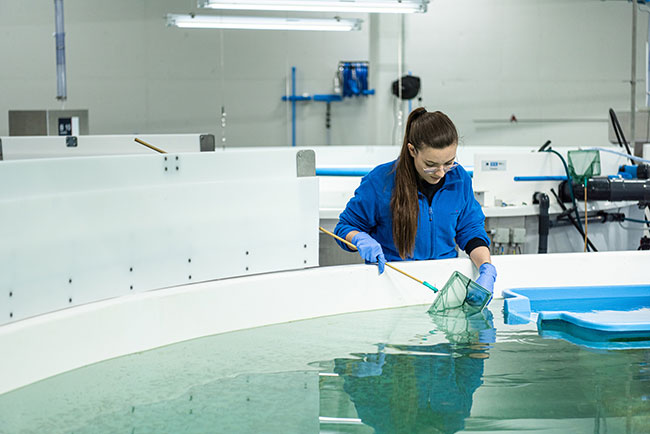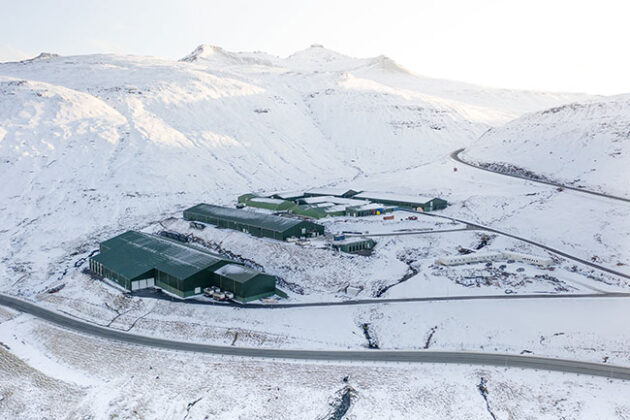
Features
post-smolt
Think bigger smolt
Lessons in growing larger smolt in the Faroe Islands
March 17, 2025 By Bonnie Waycott
 Raising smolts on land for longer periods of time will bring many advantages for when the fish are eventually put in ocean net pens for growout.
photo: bakkafrost
Raising smolts on land for longer periods of time will bring many advantages for when the fish are eventually put in ocean net pens for growout.
photo: bakkafrost Over the last decade, salmon farms have been producing larger smolts using recirculating aquaculture systems (RAS) and keeping them there for longer periods of time. An extended phase in RAS facilities on land is said to help the fish become larger and healthier, improving growth and welfare at sea. Meanwhile, reducing the length of the marine phase of production is favourable in terms of decreasing the risk of disease, escapes, exposure to sea lice, and other impacts.
Salmon farming is at the heart of the economy in the Faroe Islands. In 2023, they produced around 80,000 metric tonnes (MT) of farmed salmon, with around 90,000 MT expected in 2024. They also have extensive experience of producing larger smolt; the average size of smolts released into the sea is now more than 400 grams.
Faroese farms have been making significant investments to produce larger smolt for some time. One such farm is Hiddenfjord, which decided to increase the size of its smolts in 2010 in order to reduce sea lice exposure. Following an initial size of 80 to 100 grams, Hiddenfjord now stocks its smolts at around 700 to 800 grams and harvests after approximately 10 months (by comparison, a smolt of around 100g will remain at sea for approximately 18-20 months before reaching market size). Hiddenfjord’s goal for 2025 and the next two to three years is to release smolts of around 800 grams to one kilo and rear them at sea within a year, followed by a fallowing period of one month before the next harvest.
“Our goal is to transfer ten groups of fish to sea by Easter of next year,” said Atli Gregersen, CEO of Hiddenfjord. “Some of these might be around 700 grams, while others could be as much as 1.5 kilograms. Our trials also show that smolts of around 1.5 kilograms will reach market size and be ready for harvest within approximately eight months, while smolts of 700 grams reach market size in around 11 months. Time at sea is significantly reduced, and this is what we are focused on.”

Companies, like Hiddefjord and Bakkafrost, are making significant efforts to produce bigger smolts in order to improve overall production performance. (Photo: Hiddenfjord)
Tackling sea lice
One of the main reasons why farms are keen to produce bigger smolt and shorten production time at sea is to reduce exposure to sea lice, enhancing survival rates and overall fish welfare, said Gregersen. Once sea lice have established, they will spread fast, resulting in long-lasting impacts, such as skin erosion, physical damage and osmoregulatory failure, thereby influencing survival rates and feed efficiency, resulting in substantial costs for farmers. Indeed, these costs and the impacts of different chemical treatments are reasons behind the huge efforts being made to address the sea lice issue.
“The longer smolts remain at sea, the more sea lice they will be exposed to,” said Gregersen. “Smolts also act as hosts, which sea lice attach to before quickly producing eggs, so the situation can escalate. We know that a shorter time at sea means fewer biological challenges, and more continuous and safe production. This is the key advantage of producing bigger smolts – they are not so susceptible to sea lice. As a result, there is less need for treatment, and the smolts don’t need to be bathed, handled or pumped back and forth as much. They can be kept happier to a much larger degree. By producing bigger smolts, we reduce the risk and improve the biology of the fish.”
Keeping smolts on land for longer periods of time also brings other advantages related to addressing sea lice, said Gregersen. If sea lice levels are low in one farming site, it will not harm neighbouring sites, resulting in positive ramifications for farming locations. Farmers also do not need to transfer sea lice treatments and equipment from one site to another. This is perhaps the leading cause of disease spreading on farms, but it can be addressed by keeping smolts on land for longer and reducing the time they spend at sea.
Rúni Dam, an aquaculture consultant at Avrik, agrees with Gregersen that delousing treatments can be easily avoided with less production time at sea. His data from a Faroese farming site show that smolts of 98 grams needed three treatments to reduce sea lice count in 2013. However, in 2020, smolts of 607 grams required no treatment at all.
“The trend over the last year has been to produce smolts more slowly on land in lower temperatures, not only to reduce the time at sea and avoid sea lice exposure, but also because various science reports have shown a possible link between high intensity land production and a less robust smolt, when put to sea,” he said.

Bakkafrost plans to equip its facilities in Faroe Islands and in Scotland with up-to-date tools as part of its strategy to grow larger smolt. (Photo: Bakkafrost)
The rise in bigger smolts
Producing larger smolts provides the fish with enhanced potential when they are eventually put into ocean pens for growout. Indeed, there appears to be growing evidence that bigger is better when it comes to size.
Other positive attributes of bigger smolts include more robustness, less chances of succumbing to any change in environment, stronger swimming abilities and coping better in strong currents, better physical condition overall, and higher survival rates. Gregersen adds that ensuring high-quality smolts is also important, as they will grow quickly at sea regardless of their size.
“If smaller smolts are placed in strong currents, they will struggle more compared to larger smolts,” he said. “When it comes to size, this is, of course, very relevant. Some of our farming sites have strong currents, but we have started to use these more frequently for our bigger smolts. Regardless of size and quality, it’s also important to transfer your smolts to sea at the right time. We don’t transfer in February as this is the coldest month and the risk of winter wounds –bacteria that harm the fish – is highest. If measures are in place to ensure high quality smolts, these will have a good ability to grow quickly at sea. Fast growth is not a problem for quality, and fast-growing fish have a very good reputation in the market.”
Another Faroese firm that is making significant efforts to produce bigger smolts is Bakkafrost. Over the last 20 years, the company has grown through acquisitions and increased its farming capacity, gaining access to new fish farming fjords and building hatcheries for smolt production. Like Hiddenfjord, one of its aims is to increase sustainable growth and reduce biological risk. To this end, new hatcheries and an increased focus on large smolt are core aspects of the company’s 2024-2028 investment plan to grow a stronger and more sustainable salmon farming sector in the Faroe Islands and beyond.
“In 2024, we plan to transfer 17.7 million smolts with an average weight of 420 grams, and expect to transfer 18.5 million in 2025,” said Regin Jacobsen, CEO of Bakkafrost.
“The smolts spend around 13 months at sea and reach an average harvest weight of around five kilograms. Large, high-quality smolt are the key to growth and improvement. Farming cycles get shorter, while there is a reduced biological risk because the sea phase is shorter. Large smolts can significantly enhance operational performance, improve efficiency, and increase organic growth and harvest volumes.”
Bakkafrost has committed to building a new RAS smolt hatchery in Skálavík on the Faroe Islands. The hatchery will have a total capacity of around 4,000 tonnes yearly, and is expected to be up and running in late 2026. The Skálavík hatchery follows recent expansions in Glyvradal, Norðtoftir, Viðareiði, also on the Faroe Islands, and the ongoing construction of the Applecross hatchery in Scotland. This marks yet another important step toward farming salmon for a longer period on land, said Jacobsen.
“As part of our plan to facilitate sustained growth, we are now introducing our strategy to grow large smolts not just in the Faroe Islands but also in Scotland,” he said. “Equipping sites with up-to-date tools, including centralised feeding and introducing AI are all part of the plan.”
Toward the future
With clear benefits to producing bigger smolt, it may be tempting to label this as the future of the salmon farming industry on the Faroe Islands. However, Gregersen notes that the future will be defined not only by larger smolt, but also by farms’ ability to address challenges, such as sea lice exposure.
“Bigger smolts will partly lead to strong growth in the Faroe Islands, but we also need to know how to keep the official regulation of sea lice numbers down,” he said.
“If a farm increases the number of fish in a fjord, it will need to decrease their numbers of sea lice per fish. In this sense, we need to implement a total number of sea lice per site. We currently have a maximum number of fish that can be stocked in each site, and I am working to convince veterinarians to establish a maximum number of sea lice per site. Addressing challenges such as this is just as important as the production of bigger smolt.”
Print this page